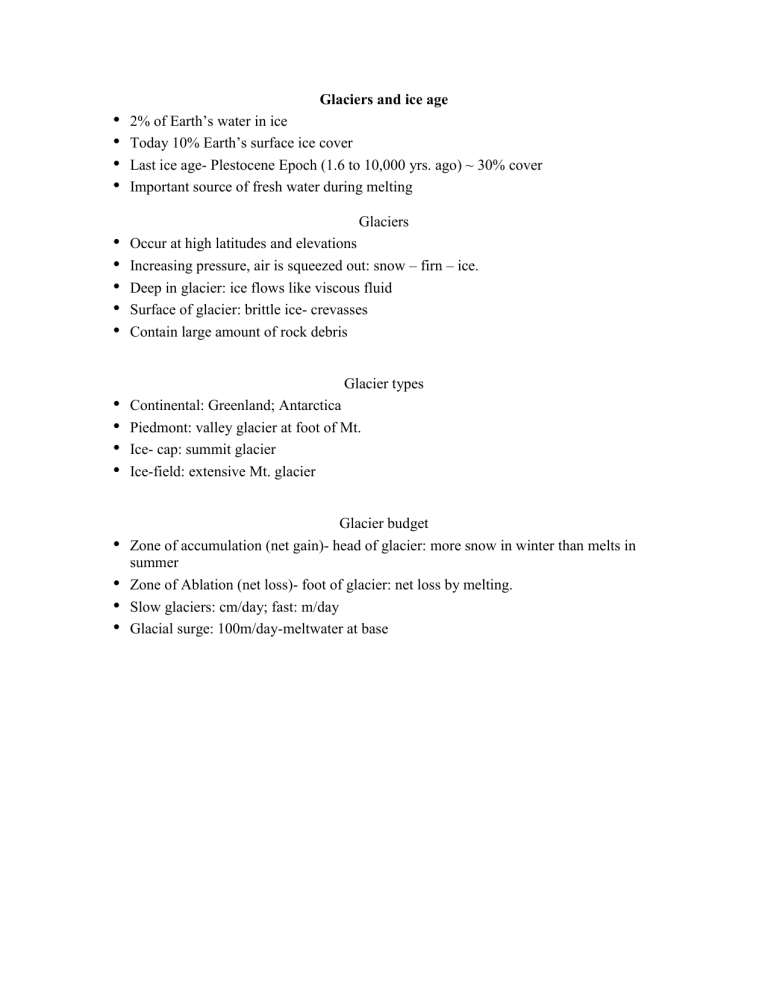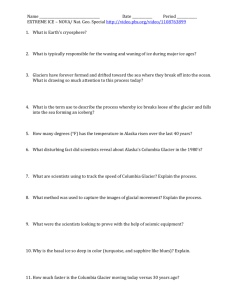Glaciers and ice age

Glaciers and ice age
•
2% of Earth’s water in ice
•
Today 10% Earth’s surface ice cover
•
Last ice age- Plestocene Epoch (1.6 to 10,000 yrs. ago) ~ 30% cover
•
Important source of fresh water during melting
Glaciers
•
Occur at high latitudes and elevations
•
Increasing pressure, air is squeezed out: snow – firn – ice.
•
Deep in glacier: ice flows like viscous fluid
•
Surface of glacier: brittle ice- crevasses
•
Contain large amount of rock debris
Glacier types
•
Continental: Greenland; Antarctica
•
Piedmont: valley glacier at foot of Mt.
•
Ice- cap: summit glacier
•
Ice-field: extensive Mt. glacier
Glacier budget
•
Zone of accumulation (net gain)- head of glacier: more snow in winter than melts in summer
•
Zone of Ablation (net loss)- foot of glacier: net loss by melting.
•
Slow glaciers: cm/day; fast: m/day
•
Glacial surge: 100m/day-meltwater at base
Glacial features
•
U-shaped valleys: formed by erosion of valley glacier (not V shaped like river)
•
Fiord: flooding of U-shaped valley
•
Deposits: Till- sediment produced by melt water (sand, gravel, boulders).
•
Moraines: landforms composed of Till.
•
End or terminal moraines: farthest extent of ice
•
Recessional moraine: retreating glacier
•
Esker: linear moraine due to meltwater
Sea-level change
•
Pleistocene glaciation: lower sealevel by 100m (300 ft)- land bridge across Bering strait (Alaska-Russia)- migration of humans/animals from Asia 11-8,000 yrs ago.
•
Caused flooding of valleys: fiords, estuaries, harbors
•
If all polar ice melts today: rise of 40m (130 ft)
•
London, L.A. Tokyo, N.Y.C. underwater
Isostaic rebound
•
Weight of 3 km (2 mi) of Pleistocene ice loaded down continental crust into Earth’s mantle.
•
Melting of ice (10,000 yrs.) resulted in slow (mm/yr) uplift of crust- raised beaches in northern latitudes- Baltic, Hudson Bay, N. Europe. Several meters uplift.
Pleistocene lakes
•
Formed by runoff of meltwater- high rainfall, lower evaporation- very large lakes: most dry or smaller now.
•
Great Salt Lake (Lake Bonneville)
•
Great Lakes, Finger Lakes, NY,
•
Pyramid Lake, Nevada,
•
Lake Agassiz, Manitoba
Pleistocene ice age
•
First recognized by Louis Agassiz, 19 th
cent. geologist.
•
Ice c overed northern hemisphere
•
Climate zones moved south
•
Animal/plants/humans moved south
•
Moana Loa (19 deg. N), Hawaii- ice cap







